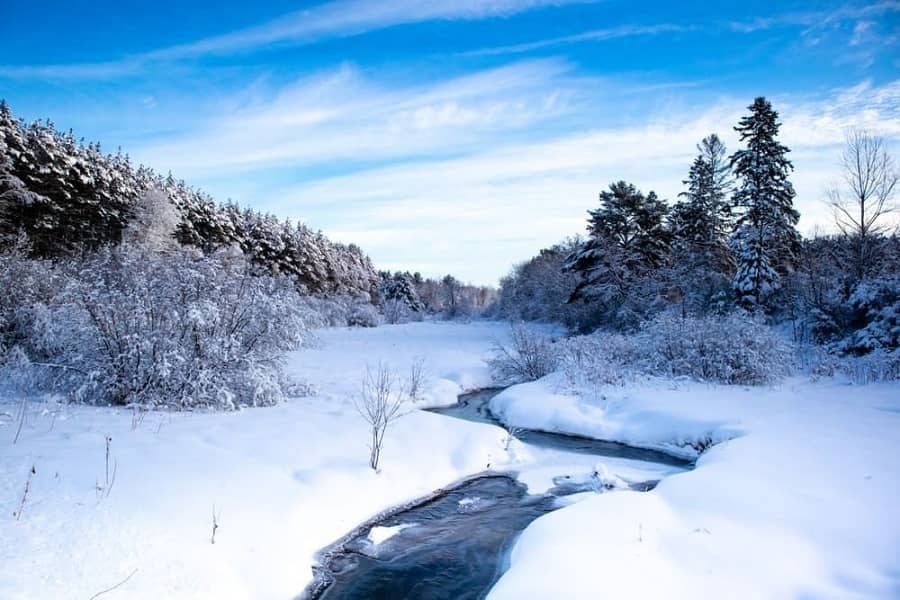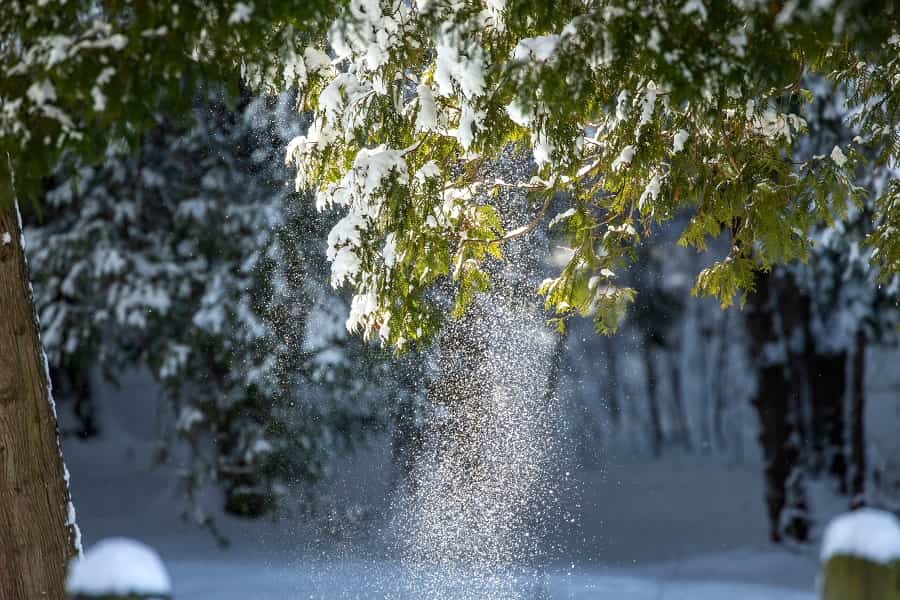The best way to prepare for this coming winter is to know what to expect. Wisconsin is familiar with hard-hitting snow, and we’re always ready to help with snow removal and ice control, ensuring your business remains open during colder months in Milwaukee, Madison, and other cities.
The best way to prepare is by understanding what’s ahead. To help you get ready, we are sharing the Wisconsin winter forecast 2023-2024 predictions.
Wisconsin Winter Forecast 2023-2024 from the Old Farmer’s Almanac
According to the trusted Farmer’s Almanac’s Wisconsin winter predictions, residents of Wisconsin are in for a stormy winter season filled with abundant snowfall and colder temperatures. Brace yourselves, as the snowiest periods are expected to occur in late November to early December and again in early to mid-January. Be proactive and ready to tackle the snowy challenges that lie ahead. Whether you hire a professional snow removal service or have a dedicated team in-house, ensuring that your business is accessible and safe for both employees and customers is of utmost importance.
Wisconsin Winter Forecast 2023-2024
As we gear up for the 2023-2024 winter season in Wisconsin, the latest meteorological data and predictions paint a picture of what residents can expect. Drawing from sources like the National Weather Service, FOX6 News Milwaukee, and Patch, here’s a comprehensive forecast for Wisconsin’s winter.
Temperature and Precipitation Outlook
- Above-normal temperatures: The Milwaukee metro area and northeastern Wisconsin have a high chance of experiencing above-normal temperatures. This trend aligns with the broader pattern of a warmer winter expected in the region.
- Drier conditions: Particularly in the north and eastern parts of Wisconsin, there’s a notable chance of a drier-than-normal winter. However, southwestern Wisconsin shows an equal likelihood of above and below-normal precipitation.
Influence of El Niño
- El Niño’s impact: This winter is forecasted to be a strong El Niño year. El Niño, characterized by the warming of ocean water in the equatorial Pacific, influences the jet stream and, consequently, weather patterns in the U.S.
- Potential weather patterns: With El Niño, Wisconsin might experience a shift in storm tracks, potentially affecting the amount and distribution of snowfall. While the state is expected to have a warmer and drier winter, occasional cold snaps and snow are still likely.
Snow in Wisconsin in 2023-2024 – What to Expect

As Wisconsin residents look ahead to the 2023-2024 winter season, the question on many minds is, “How much snow will we get?” Based on the latest meteorological forecasts and trends, here’s an overview of what Wisconsinites can expect in terms of snowfall this winter.
The upcoming winter is forecasted to be strongly influenced by El Niño, a climatic event characterized by warmer ocean waters in the equatorial Pacific. This phenomenon typically alters weather patterns across the United States, including Wisconsin.
El Niño generally leads to warmer and drier conditions, which could mean less snowfall than average in Wisconsin. However, the exact impact on snow levels can vary, and occasional snowstorms are still likely.
Predictions from Key Sources
- National weather service outlook: The NWS suggests a drier and warmer winter for Wisconsin, which could translate to less snowfall, especially in the northern and eastern parts of the state.
- Farmers’ Almanac forecast: Contrary to the NWS outlook, the Farmers’ Almanac indicates that the Upper Midwest might experience an average winter in terms of snowfall, offering hope for those who enjoy winter sports.
- The Old Farmer’s Almanac: Echoing the Farmers’ Almanac, The Old Farmer’s Almanac also predicts average snowfall for the region, suggesting that snow enthusiasts might not be entirely disappointed.
Local Factors to Consider
- Lake effect: Wisconsin’s proximity to Lake Michigan can lead to lake-effect snow, which might increase snowfall in certain areas, particularly along the lake’s shoreline.
- Storm tracks: The placement and movement of low-pressure systems will play a crucial role in determining snowfall distribution and intensity across different parts of Wisconsin.
The winter of 2023-2024 in Wisconsin is set to be an interesting one, with the influence of El Niño suggesting a warmer and drier season. However, the possibility of average snowfall, as indicated by some almanacs, means that residents should be prepared for a range of winter experiences. From occasional snowstorms to milder periods, this winter could offer a bit of everything.
Farmer’s Almanac Wisconsin Winter 2022 Predictions
The Farmer’s Almanac predicted a winter weather forecast for Wisconsin based on the switch from La Nina to El Nino.
El Nino and La Nina were climate patterns that originated in the Pacific Ocean. These climate patterns drastically impacted the average temperatures and precipitation rates of different regions around the globe. In the fall of 2022, La Nina was predicted to switch to the less volatile El Nino weather pattern.
In December 2022, the weather forecast predicted extremely cold temps for the Great Lakes, Wisconsin, and the upper Midwest. Some precipitation occurred, and icy conditions were present throughout the upper Midwest sometime in late December. Based on the farmer’s almanac, we expected these extremely cold temperatures to continue from early December into late January and even mid-February. The farmers’ almanac expected the heaviest snowfall in November and early December.
January 2023 saw more of the same for the Great Lakes and upper Midwest based on the farmer’s almanac winter 2023 prediction. Temperatures hovered between 17º and 26º Fahrenheit. We didn’t expect to see much rain but far more snow during late January. Specifically, the snowy period carried from 2022 into early and mid-January.
Our February Wisconsin winter forecast 2 023 saw more of the same weather conditions, with temperatures averaging between 19º and 28º Fahrenheit. We expected average winter snowfall due to the more predictable El Nino-influenced winter forecast for Wisconsin 2022-2023.
What Was Winter 2022-2023 Weather in Wisconsin?

- December 2022 — November was filled with sunshine, but it gave way to a cloudy sky for much of the month. Snowfall became frequent, with most areas receiving snow on December 9.
Starting from December 15, there was a 10-day period of snowfall across the state. Southern Wisconsin experienced up to 10 inches of snow, while northern Wisconsin saw snow totals exceeding two feet.
As the third week of the month arrived, bitter cold air set in, with some areas experiencing subzero highs right before Christmas. Relentless winds battered the state, creating wind chills as low as 30 degrees below zero throughout Wisconsin.
However, as December drew to a close, there were indications of mild air returning, with temperatures potentially reaching near 50 degrees around December 29-30. - January 2023 — January 2023 in Wisconsin was unusually warm, with temperatures 7.7 degrees higher than the long-term average. The entire state experienced above-average temperatures, ranging from 8 to 11 degrees higher than normal. January was also wetter than usual, with precipitation 37% above average. Snowfall varied across the state, with a deep snowpack in the northwest and less snow in the central and eastern regions. The month was characterized by persistent cloudiness, making it the cloudiest January in 18 years of data.
- February 2023 — February 2023 in Wisconsin was remarkably wet, ranking fifth wettest on record. The entire state experienced exceptionally wet conditions, with all climate divisions reporting over 200% of normal precipitation. A heavy rainfall event on the 27th caused significant rain, especially in the far south. February also saw high snowfall in northern and east-central regions, maintaining the deep snowpack in northwest Wisconsin. The winter of 2022-2023 was the wettest on record in Wisconsin, with above-average precipitation in all three months. Despite December being colder than normal, January and February were unusually warm.
Snow in Wisconsin in 2023-2024 – What to Expect
In Wisconsin, during the winter of 2023-2024, the impact of a strong El Nino is expected to play a significant role in weather patterns, which will require much preparation for businesses and homeowners. Here is what can be expected regarding snow in Wisconsin during this period:
- More snowfall: Due to the El Niño weather pattern, the storm tracks are expected to shift towards the southern United States, resulting in Wisconsin potentially experiencing more snowfall compared to average winters. It is always wise to stay prepared and monitor weather forecasts for the most accurate and up-to-date information regarding snowfall expectations in your area.
- Variable conditions: While the overall trend for Wisconsin may lean towards above-normal snowfall due to El Niño, it’s important to note that the strength and positioning of the weather pattern can result in variability. This means that there may still be fluctuations and storms that could impact the actual snowfall amounts experienced in the region.
- Cold temperatures: The temperatures during the winter in Wisconsin are expected to be colder, particularly in the inland areas. This means that when precipitation does occur, there is a higher likelihood of it falling as snow.
- Potential for ice events: With the storm track further south, the boundary between the colder air in the north and warmer air in the south might lead to freezing rain or sleet in some cases, rather than just snow.
Residents of Wisconsin should keep a close watch on weather forecasts as the winter progresses and be prepared for variable conditions. It’s essential to take necessary precautions for cold weather and have contingency plans in place for snow and ice events.
How to Prepare for the 2023-2024 Winter Season in Milwaukee

Business owners and households across the region would be wise to familiarize themselves with the Wisconsin winter forecast and start stocking up on salt suppliers (stored in a cool, dry place). And, of course, having a snow contingency plan in place is important so everyone knows what to do if there’s a snow emergency.
It’s also important to analyze your outdoor area and repair any potholes or cracks in paving, pathways, and parking lots. They’re problematic for two reasons, the first being that someone could trip, and the second being that the freeze-thaw effect of ice and water will expand the cracks as the seasons go by.
The most effective way to prepare is to hire the help of expert snow removal contractors. At Earth Development, we have more than 20 years of experience providing reliable snow and ice management services to businesses. We are taking the requests for snow removal for the next 2022-2023 season!
Get Your Free Snow Removal Quote Today!

To ensure your business remains operational even in harsh winter weather, we invite you to get a fast quote. Our team of experts is ready to discuss your seasonal plans, the comprehensive commercial snow removal services we provide, and how they can help your property stay safe all year round.
We understand the importance of keeping your property clear of snow and ice, so we will conduct a thorough assessment of your premises. Based on this evaluation, we will develop a customized snow and ice management plan tailored to your specific needs. Don’t let winter weather disrupt your business — let us handle the snow and ice so you can focus on running your operations smoothly. Contact us today!
